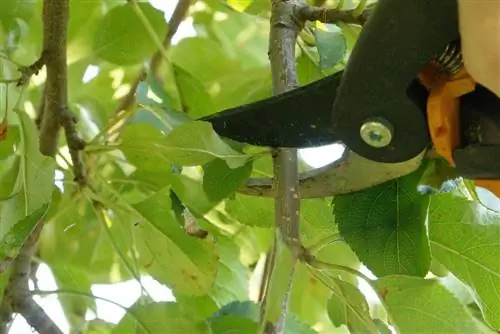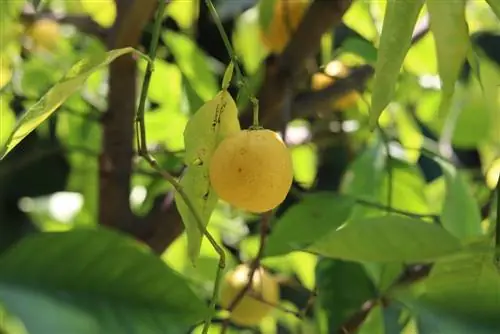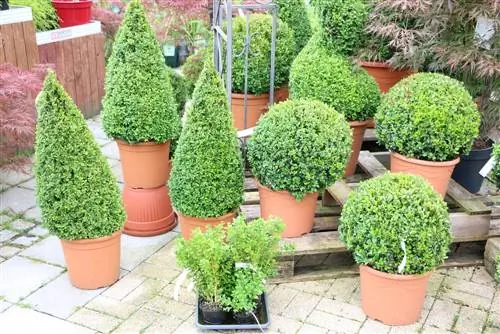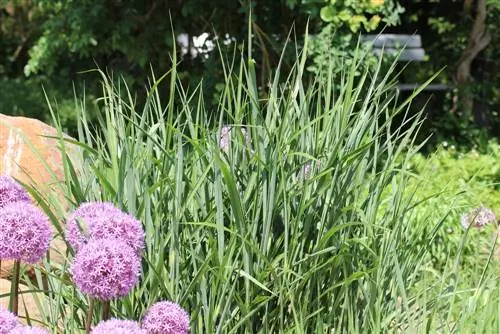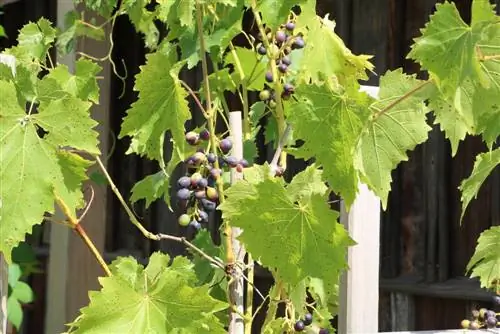- Author admin [email protected].
- Public 2023-12-17 03:39.
- Last modified 2025-01-24 12:45.
Impressive, decorative and easy to care for - anyone who decides to cultivate miscanthus as a hobby gardener can look forward to a real eye-catcher in their home green space. The lush plant with long reed leaves and dark purple flower spikes is probably originally native to the subtropical regions of central Japan, but is increasingly being cultivated in Central Europe. Here, the plant, which is up to four meters high, also serves as a wintering quarters for microorganisms such as beetles and spiders. In this way, the hobby gardener also offers valuable living space for beneficial insects.
Location
Although Miscanthus comes from Asia and is used to the climatic conditions there, the plant also does well in Central Europe. Above all, the plant has adapted to the conditions in this area in recent years; For example, the flowering period is scheduled for the end of summer.
However, careful choice of location is of great importance to ensure good prosperity and lush growth. The hobby gardener should choose a place for the plant that meets the following criteria:
- as sunny a location as possible
- sufficient brightness
- light shade is also tolerated
Even if the plant also develops in locations with only moderate sunlight, the location must not be too shady; The result is weak growth and poor flowering. In addition, the entire plant is weakened and more susceptible to disease if it is constantly in the shade.
So that the plant can develop optimally, the most suitable locations are sunny borders and perennial beds.
Substrate
So that the Miscanthus feels comfortable, the hobby gardener should not only place emphasis on a suitable location but also on the right substrate. The plant is fundamentally tolerant when it comes to general soil requirements; However, it must not be too dry. Overall, the following criteria should be taken into account when choosing a substrate:
- sufficient nutrients in the substrate
- humous properties
- moist but permeable consistency
- Enrichment with peat or compost
- no soil compaction
Tip:
When keeping Miscanthus, good drainage is recommended, which ensures optimal drainage. However, the plant thrives less on permanently moist soils.
Watering and fertilizing
Miscanthus prefers moist soils; For this reason it is necessary to water the plant regularly. The frequency and amount of water supply also depends on the individual location and also on the substrate used for cultivation; If the plant is in partial shade, both the amount and frequency of watering can be reduced, while if the plant is in full sun, care must be taken to water frequently. Freshly planted plants need a lot of moisture.
Regardless of the amount of water given, well-functioning drainage is also important to avoid standing water. It requires a bit of sensitivity to ensure that the soil is always slightly moist on one side and not to cause waterlogging on the other side.
With regular watering, the plant basically receives everything it needs to live; additional fertilization is not absolutely necessary. Only if a humus-rich and fertile substrate has not been chosen for cultivation should one resort to targeted administration of nutrients. The following aspects must be taken into account:
- the administration of complete fertilizer is recommended
- ashes from the oven can also be used
- Manure or liquid manure should not be used
- There is no fertilization in the year of planting
Cutting
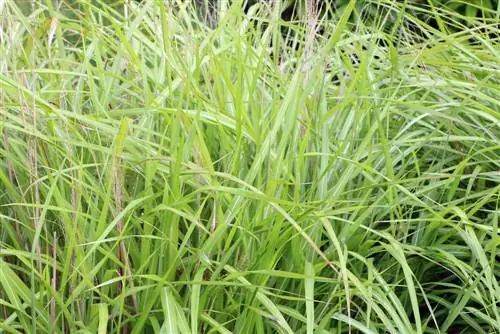
Caring for miscanthus includes regular trimming of the plant. Plant experts do not agree on the optimal time for this measure. On the one hand, targeted pruning is recommended in the fall so that it can quickly sprout again in the spring. But on the other hand, cutting can also cause damage to the plant; Since the stalks of miscanthus are hollow, there is a risk that water will collect inside them during the cold season. As a result, the plant begins to rot. In addition, the fronds also offer decorative advantages, which - covered with hoarfrost in winter - represent a visual highlight within the local green area. In addition, the snow-covered tufts add structure to the garden.
Regardless of the time of pruning, the following aspects are important for this measure:
- Pruning the plant close to the ground
- cut in bunches
- Use secateurs with high leverage for cutting
- Wear gloves when cutting (risk of injury from sharp edges!)
Wintering
Miscanthus is one of the plants that can be easily overwintered; Even in rough locations, there is usually no risk of the plant freezing. In order to provide natural winter protection, you can avoid pruning in the fall; Otherwise, no additional protective measures are required for adult plants. Only young reeds should be protected from low temperatures as they are not yet hardened. In addition, it can make sense to provide winter protection for plants that are grown in buckets or pots.
Then the following measures are necessary:
- Tie free reeds together to avoid damage from snow load.
- Place the bucket on a Styrofoam plate
- Wrap pots with fleece
It is often advised that reeds do not need to be tied together; However, this recommendation particularly applies to older specimens. If the plant was grown in the same year, it is a good idea to offer the plant some protection during the cold season; Then over time it becomes stronger and more resilient and survives the following winters without any problems without further protection.
Tip:
Some varieties are particularly robust against snow. The miscanthus 'Silverfeder' (Miscanthus sinensis), for example, stands up again by itself when the snow load has been roughly removed.
Plants
If you want to plant miscanthus in your garden, you should wait until spring; May is the best time to plant the plant. As a rule, the plant is only available from online providers at this point; But even in the period between the end of June and the beginning of July, when local nurseries offer the plant, it is still worth growing.
When planting, it has proven useful to calculate enough space for the miscanthus in advance so that the plant can be optimally displayed within the local green area. For the higher varieties, an area of one square meter is recommended. The plant looks particularly decorative in combination with sunflower, torch lily and phlox, which should therefore be cultivated in close proximity to the miscanthus. When planting itself, the following aspects should be taken into account:
- Maintain a planting distance of between 30 and 120cm (depending on the variety)
- Install rhizome barrier if there is a high-maintenance green area nearby
- Spread can also be slowed down using bottomless mortar pots as planters
- Water the reeds well
- Remove weeds regularly, as young plants are sensitive to root competition
Propagate
Those who cultivate miscanthus usually don't need to worry about actively propagating the plant. It is a fast-growing plant that spreads quickly throughout the garden. After just a few years it is able to take over large areas and push back other plants.
Otherwise, active propagation works easily via division; This is also done when the reeds have become too large. Spring is best suited for this measure. The rhizomes are then dug up, which is often very laborious and is best done with a sharp spade due to the very dense network of roots. After digging up and dividing the roots, the grass must be placed directly back in the desired location so that it can quickly form roots and grow optimally.
Basically, targeted sowing of seeds can also be chosen as a propagation method; However, the hobby gardener should have a lot of patience in this case, as the plant takes a long time to grow.

Diseases and pests
Every plant can be attacked by pests and diseases. Here are the most common problems.
Brown leaf discoloration
Overall, miscanthus is robust against diseases and pest infestation. However, brown spots sometimes appear during the first warm days of spring, which can indicate the following symptoms:
- Rotting of the plant (high risk after cutting off the stalks in autumn)
- Water shortage
- Sunburn
If the plant is completely rotten, it can no longer be saved; Otherwise, it is possible to divide the plant and reuse the he althy reed. If a lack of water is the reason for the leaf discoloration, the plant overall looks limp. Then thorough watering helps. However, if the hobby gardener only sees partial brown spots on the leaves and the plant otherwise looks he althy, it is usually sunburn. These symptoms are often triggered when the miscanthus is immediately exposed to the blazing sun after moving from its winter quarters outdoors. To prevent sunburn, the plant should be acclimated to the sun slowly; In addition, watering from above should be avoided, as the drops of water on the leaves act like a magnifying glass and can intensify the symptoms. Basically, the newer varieties of miscanthus with variegated leaves are particularly affected by sunburn; Especially variants with horizontally striped leaves that are cultivated on dry soil quickly show these symptoms.
mealybug infestation
In rare cases, Miscanthus is attacked by the Miscanthus mealybug, which occurs primarily in North America. The presence of the pest can be easily recognized by the cotton ball-like formations on the leaves and the waxy excretions of the louse. The following measures help to combat this:
- remove diseased plant parts
- Apply neem oil to the plant
- Use a mixture of spirit, water and soap
- Use parasitic wasps or ladybirds as natural enemies of the louse
If the pest has been successfully eliminated, the hobby gardener can then look forward to the he althy growth of the miscanthus again. If optimally cared for, he will certainly enjoy the decorative plant for many years to come!


